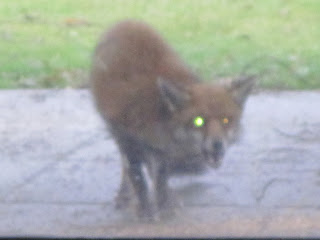 A grey Saturday when the rain clouds moved away. We drove across country to the Dorset country town of Wimborne Minster and then travelled a few miles further west to the country estate of Kingston Lacy.
A grey Saturday when the rain clouds moved away. We drove across country to the Dorset country town of Wimborne Minster and then travelled a few miles further west to the country estate of Kingston Lacy.Kingston Lacy House was built in 1663 , during the Restoration monarchy, by Sir Ralph Bankes. It has been changed by subsequent members of the Bankes family, and in the 1830s it was re-designed as a Venetian Renaissance palazzo, which gives it the European elegance that survives in its appearance today. The Bankes family enlarged the estate to over 8000 acres. There are twelve working farms, parkland designed in the 1780s by Henry Bankes and areas of wild wood and more formal gardens.
In 1981, the Kingston Lacy Estate was bequeathed to the National Trust by Ralph Bankes. Today, the house and its magnificent collections of art and artifacts are open to visitors during the summer months. In the winter, the estate closes to the public, but reopens during early spring weekends as the woods and gardens bloom in a profusion of snowdrops.
 In the walled garden, cyclamen and snowdrops flower in the shade of trees. The snowdrop collection contains many species of snowdrop, including the wild snowdrop of English woodlands.
In the walled garden, cyclamen and snowdrops flower in the shade of trees. The snowdrop collection contains many species of snowdrop, including the wild snowdrop of English woodlands.


 Walking out of the walled garden, the rear of the house can be seen across well-tended box hedging.
Walking out of the walled garden, the rear of the house can be seen across well-tended box hedging. Looking back along a wet parkland path towards the house. The parkland retains many fine old trees, both evergreen and deciduous. There is continuous care of the old trees and the careful planting of new, young trees which will eventually replace them.
Looking back along a wet parkland path towards the house. The parkland retains many fine old trees, both evergreen and deciduous. There is continuous care of the old trees and the careful planting of new, young trees which will eventually replace them. Along one of the snowdrop avenues.
Along one of the snowdrop avenues. Snowdrops in the woodland.
Snowdrops in the woodland.
 Along the tree lined avenues, snowdrops bloom like drifts of snow. Amongst the flowers are the spears of bluebells and young daffodils which will blossom under the trees in later spring.
Along the tree lined avenues, snowdrops bloom like drifts of snow. Amongst the flowers are the spears of bluebells and young daffodils which will blossom under the trees in later spring.
 Splashing in the puddles left by overnight rain.
Splashing in the puddles left by overnight rain.
 Another woodland walk with newer plantings of snowdrops.There were people of all ages here today, walking and enjoying the peace of the woods, but there is space enough sometimes to find an empty pathway ahead.
Another woodland walk with newer plantings of snowdrops.There were people of all ages here today, walking and enjoying the peace of the woods, but there is space enough sometimes to find an empty pathway ahead. Young bamboo grows out of a cloud of snowdrops near the Japanese Garden
Young bamboo grows out of a cloud of snowdrops near the Japanese Garden
 Snowdrops beneath flowering Mahonia japonica.
Snowdrops beneath flowering Mahonia japonica.
 In the wild wood, moss covered tree trunks and fallen branches lie amid a carpet of snowdrops. Old wood remains here to provide food for invertebrates as it rots away.
In the wild wood, moss covered tree trunks and fallen branches lie amid a carpet of snowdrops. Old wood remains here to provide food for invertebrates as it rots away. A quiet place to rest in a wild woodland glade.
A quiet place to rest in a wild woodland glade. Across the woodland edge where majestic old Cedars of Lebanon stand in the parkland beyond.
Across the woodland edge where majestic old Cedars of Lebanon stand in the parkland beyond. A gate into the park and a grassy way across to the house.
A gate into the park and a grassy way across to the house. A dense and beautiful carpet of flowers stretching into the woods as far as the eye could see. A reminder that the seasons are turning and that the end of this long and dreary winter cannot be too far away.
A dense and beautiful carpet of flowers stretching into the woods as far as the eye could see. A reminder that the seasons are turning and that the end of this long and dreary winter cannot be too far away.








































